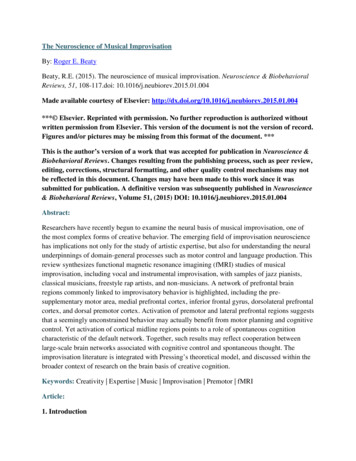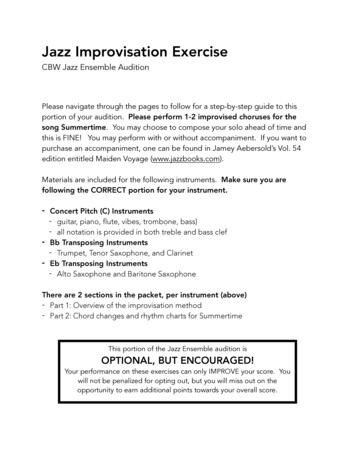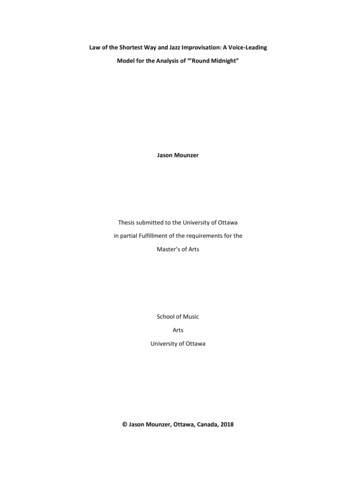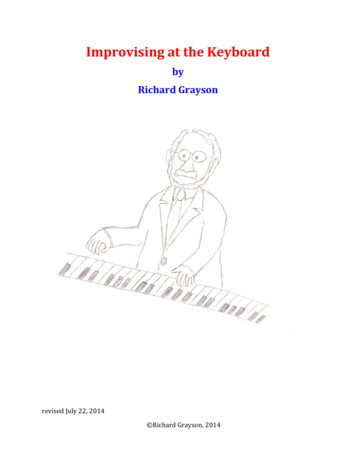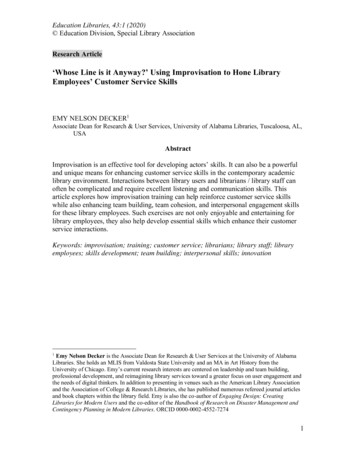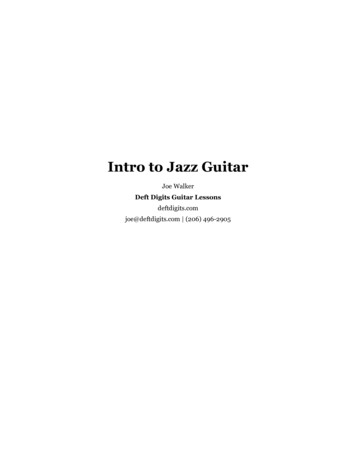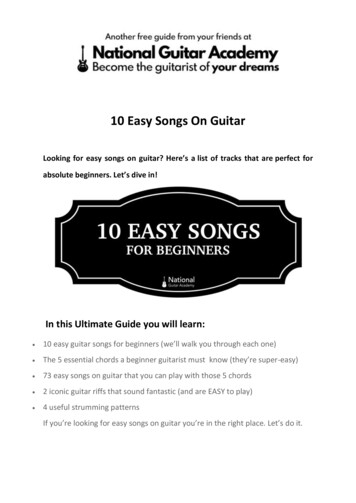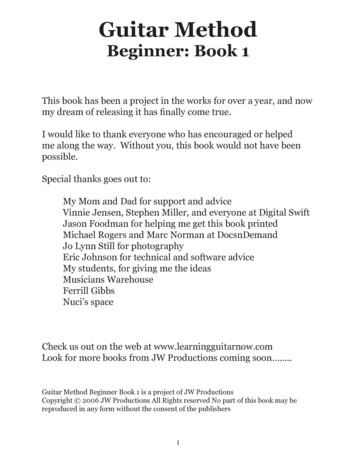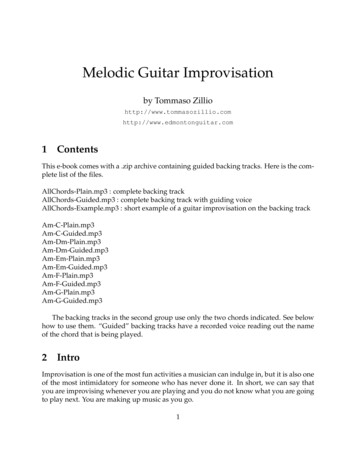
Transcription
Melodic Guitar Improvisationby Tommaso tonguitar.com1ContentsThis e-book comes with a .zip archive containing guided backing tracks. Here is the complete list of the files.AllChords-Plain.mp3 : complete backing trackAllChords-Guided.mp3 : complete backing track with guiding voiceAllChords-Example.mp3 : short example of a guitar improvisation on the backing .mp3The backing tracks in the second group use only the two chords indicated. See belowhow to use them. “Guided” backing tracks have a recorded voice reading out the nameof the chord that is being played.2IntroImprovisation is one of the most fun activities a musician can indulge in, but it is also oneof the most intimidatory for someone who has never done it. In short, we can say thatyou are improvising whenever you are playing and you do not know what you are goingto play next. You are making up music as you go.1
As for everything in music, there are countless different approaches to improvisation.On the other hand, there are some tricks that can improve your skills no matter whatyour approach is. Here we are going to cover what is called “chord tones soloing”. Agood familiarity with this concept is mandatory if you want to be able to play soulfullyand melodically.3The First StepLet’s start with something simple. First of all, take your guitar and make sure that it istuned properly. We want to train your ears too, so it’s important your the guitar is in tune.Let’s learn the following scale:This scale is called “A minor pentatonic” and starts at the 5th fret. Just play it up anddown a couple of times, like this: 8 58575757585858 5 7575758 5As soon as your fingers are familiar with the shape of this scale, play one of the backingtracks included with this e-book, in the meantime play random notes on this scale withyour guitar. Yes, you heard me correctly, play random notes. I know it does not make anysense to you, just do it. Seriously, stop reading right now and do it. It is fundamental thatyou have first-hand experience on that.Ok, I am assuming that you did it. Do not keep reading if you didn’t do it. I am alsogoing to assume that you were not very satisfied with the results. In this moment that isnot important. What is important is if there is something we can do to make you soundbetter. Of course there is, so keep reading.2
4Use chord notesYou may have noticed that when you played random notes over the backing track some ofthem were good, and other were so-so. The question is: what notes are good? To answerthis we will need a bit of music theory (just a tiny tiny bit, so don’t be frightened!).The basic piece of information is that each chord is composed by (at least) three notes.For instance, the C major chord is composed by the C note, the E note and the G note. TheA minor chord is made by the A note, the C note, and the E note. There are rules on howto find the notes corresponding to each chord, but we are not going to learn them rightnow — as you will see below, you will not need them to do what we have to do.What you DO need to know is that the “right notes” are the ones composing the chordthat is playing in that moment. So, if the backing track is playing a C major chord, theright notes are C, E, and G. If it’s playing an Am chord, the right notes are A, C, and E.As you see, all this thing about playing chord notes is easier said than done. Howcan you possibly 1) know what chord is playing right now 2) remember the notes of thischord 3) find them on the fretboard and 4) play them, all at the same time? Chances arethat before you can do all that, the chord has changed! Yet, good players are doing it allthe time, so the real question is: how they are doing it?The secret is to become familiar with every one of these steps separately until theybecome second nature; then performing them all together is not difficult anymore. I haveput together an easy system to help you play using chord notes even if you can’t (at themoment) do all the required steps in real time. So, here’s how we will overcome all thedifficulties:1. You will not have to remember what chord is playing at any given moment, sinceI prepared for you a “guided” version for each backing track, where I am going tospell what chord is playing each time.2. You will not need to remember the notes of the chord, or find them on the fretboardsince I prepared for you a series of scale diagrams where these notes are highlighted(see the last page of this e-book).3. The only thing you will have to do is PLAY!To make the learning process really comfortable for you, I have prepared a series ofexercises that you should follow in the order presented here. I know that the first one ortwo sound really easy to do, but you should do them anyway. They are going to trainyour brain and fingers to perform movements that will be useful in the next exercises.Now have a look at the scale diagrams at the end of this e-book. There is one scalediagram for each chord. The notes marked in red are the chord notes of that particularchord. Ignore the green notes for the time being. Now get the backing track “Am-GGuided.mp3”. As the name says, this backing track has only the two chords Am and G.Each exercise below must be done for at least a full play of the backing track. Do notskimp on the basics, and you’ll see that the advanced exercises will be easy.3
4.1ExercisesExercise 1. When the backing track is on Am, play one Am chord note. When it goes on G, playone G chord note. Rules: You can play ONLY ONE note per chord , and it MUST be a chord note.You have the freedom of choosing which particular chord note you are going to play.Example: AmGAm75GAm57 8 5Exercise 2. Same as before, but now play only “wrong” notes. I want you to hear how the “right”notes are actually more consonant with the chord, and how the “wrong” one sound dissonant.Dissonance is not necessarily bad, but for now we want to avoid it.Example: AmG75AmG85Am 8 7Exercise 3. Same as Exercise 1, but now play TWO different chord notes per chord. Not one, notthree, but precisely two. Remember, you can play only “right notes”.Example: AmGAm8 757855G7Am57Exercise 4. Same as the previous exercise, but now you are free to choose if you want to play one,two or more notes per chord. You can play two notes on Am, then three on G, then only one on thenext Am, and so on. You are still allowed to use only chord notes, of course.4
Example: AmG8 57587Am G 55Am 75The goal of these first exercises is to have you memorize the chord notes for Am andG. It is important to listen to the notes you are playing, so that your ear will start torecognize them. This is not “music” yet, we are just setting things up in order to playmore complicate things.In the following exercises we lift the restriction of playing only chord notes. You canplay whatever you want on any chord, and we are going to restrict only one or two notesper melodic phrase.Exercise 5. Play short phrases (2-4 notes, not more!), one phrase per chord. The only restrictionis that the LAST note of the phrase should be a chord note. The other notes may or may not be achord note, but the last one has absolutely to be one.Example: Am Am 8 G7 5 577 5 75 7Exercise 6. Again play only short phrases (2-4 notes), but this time start all the phrases on Amwith an Am chord note, and end them on G with a G chord note.Example: 8 GAm 75575
This last exercise will teach you how to connect two chords. It is important that you donot fall into the habit of playing one phrase per chord, but rather that you try to connectthem by playing trough the chord change. If you begin with a chord note of the first chordand end with a chord note of the second one then your phrase will sound good.Now repeat all the exercises for all the two-chords backing tracks. When you havedone the exercise sequence for all of the backing tracks, repeat it one last time with the“all chords” backing track, that is noticeably more complicated since, as the name says,has all the six chords into it. Doing all the exercises in the order presented here will trainyour ear and not only your fingers, so that in future, even if you do not know what chordsare playing, you will hear if the note you are playing is one of the “right” ones or not. Witha bit of experience you will than be able to rely completely on your ear without thinkingabout chords all the time. So do all the “easy” exercises and you will get results.4.2The green notesThe green notes in the scale diagrams are additional notes that are outside of the scale weare considering, but still are part of the chord played. If this last sentence confused you,fear not. Just do again the exercises above and consider the green notes as “right notes”.You will discover some more melodic possibilities using them. Remember that, at the endof the day, the important thing is that you like the music you are able to play, and not ifyou are doing everything “by the book”.5How to use the backing tracksAs I said before, one of the problems of all this ideas is that you HAVE to know whatchord is playing at any given moment. This usually means that you have to memorizethe chord progression of a backing track, and keep count of where you are. To make thingseasier for you, I prepared all the backing tracks included here in two version: “plain” and“guided”. The plain version is just a standard backing track, while the guided versionhas a voice added that reads the chords in real time. This way you can keep track of thechords effortlessly.6How to use the diagramsHere are the diagrams for the major and minor chords in the key of A minor. These areall the chords you need to get started. My suggestion is that you print them so that youcan see them while you are playing. After doing the exercises for a coupe of times, youwill see that you can remember them with no effort. You will also discover that yourimprovisations will start to be more ear-driven rather than finger-driven, meaning thatyou will start to search for a certain sound and not just play what it is easy to play.6
The notes in RED are the chord notes for the chord considered, also called the “right”notes. The notes in GREEN are optional notes that are outside the basic scale we are using,but that work well on some chords. Ignore the green notes the first time you are doingthe exercises. When you have completed a first round through all the exercises then comeback and add the green notes too. Some of them sound really sweet if played at the rightmoment (just a bit of experimentation will put you on the right track).7In the endRemember that the important things are:1. Making music2. Having funTake it easy and make baby steps until you can master the concepts that I explainedhere. You’ll see that if you follow the exercises soloing melodically will become secondnature very soon. Enjoy!7
AmCDmEmFGc 2010 Tommaso Zillio - All Rights Reserved.8
Let’s start with something simple. First of all, take your guitar and make sure that it is tuned properly. We want to train your ears too, so it’s important your the guitar is in tune. Let’s learn the following scale: This scale is called “A minor pentatonic” and starts at the 5th fret. Just play it up and down a couple of times, like this: 5 7 5 8 5File Size: 402KBPage Count: 8

